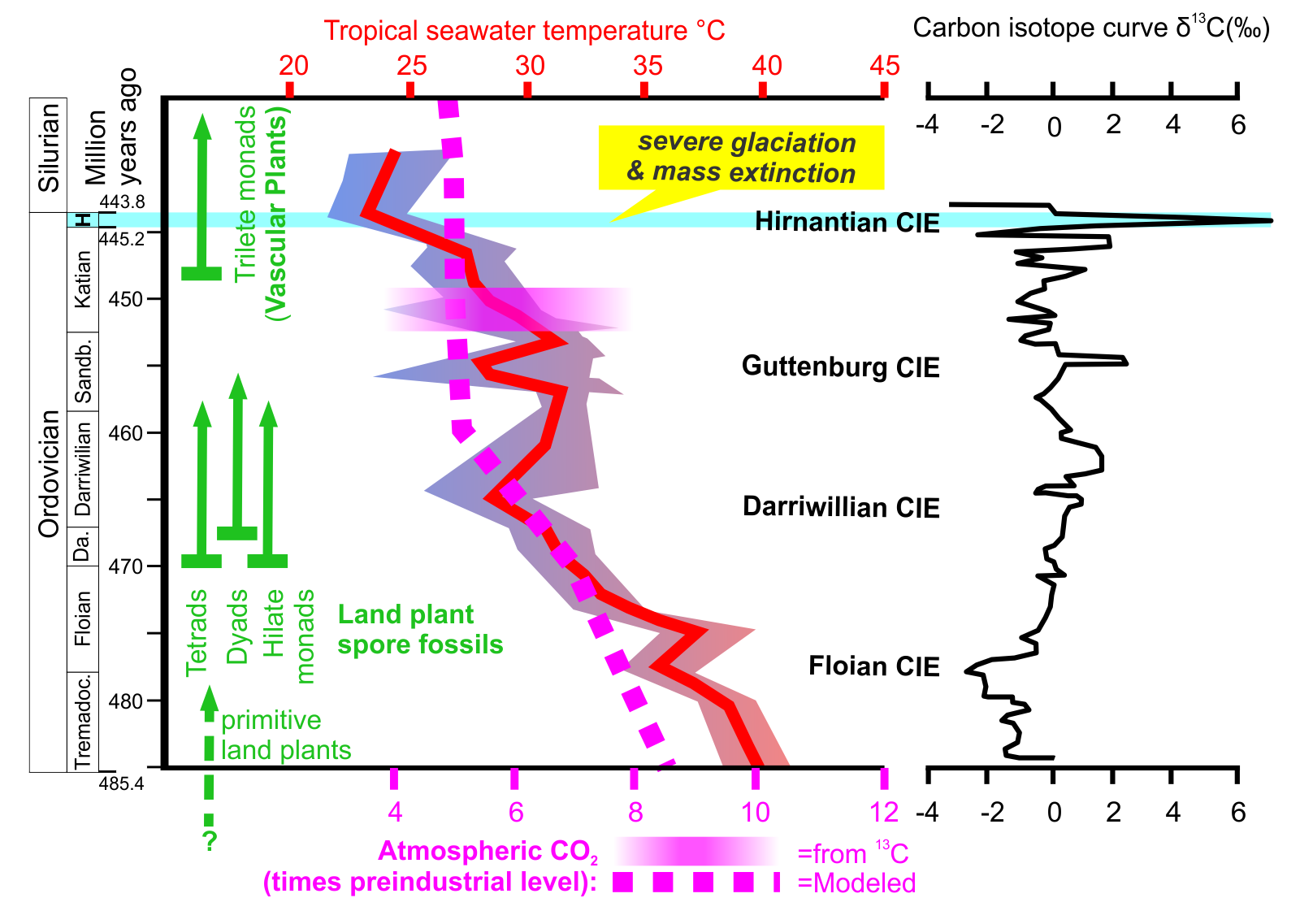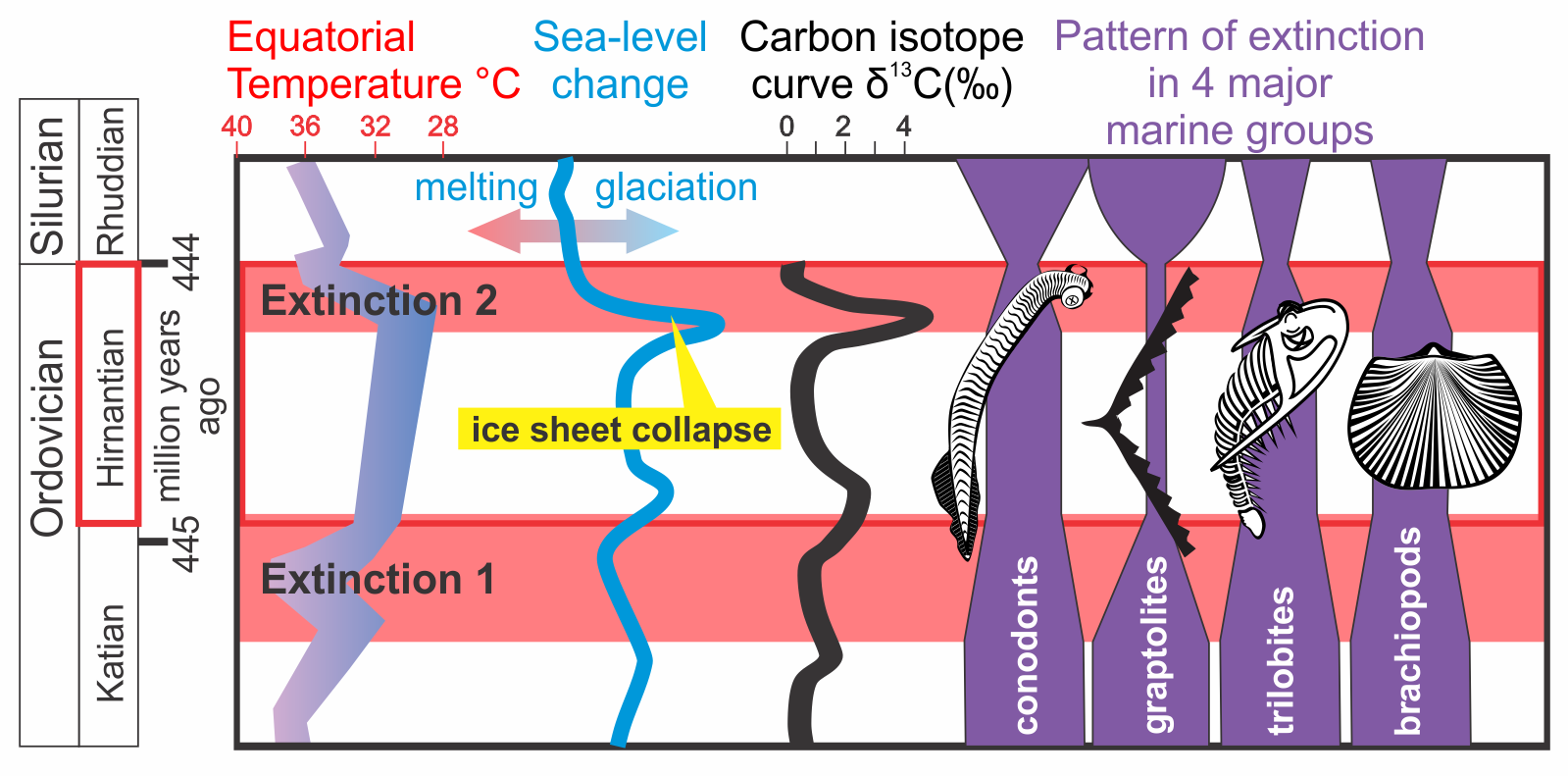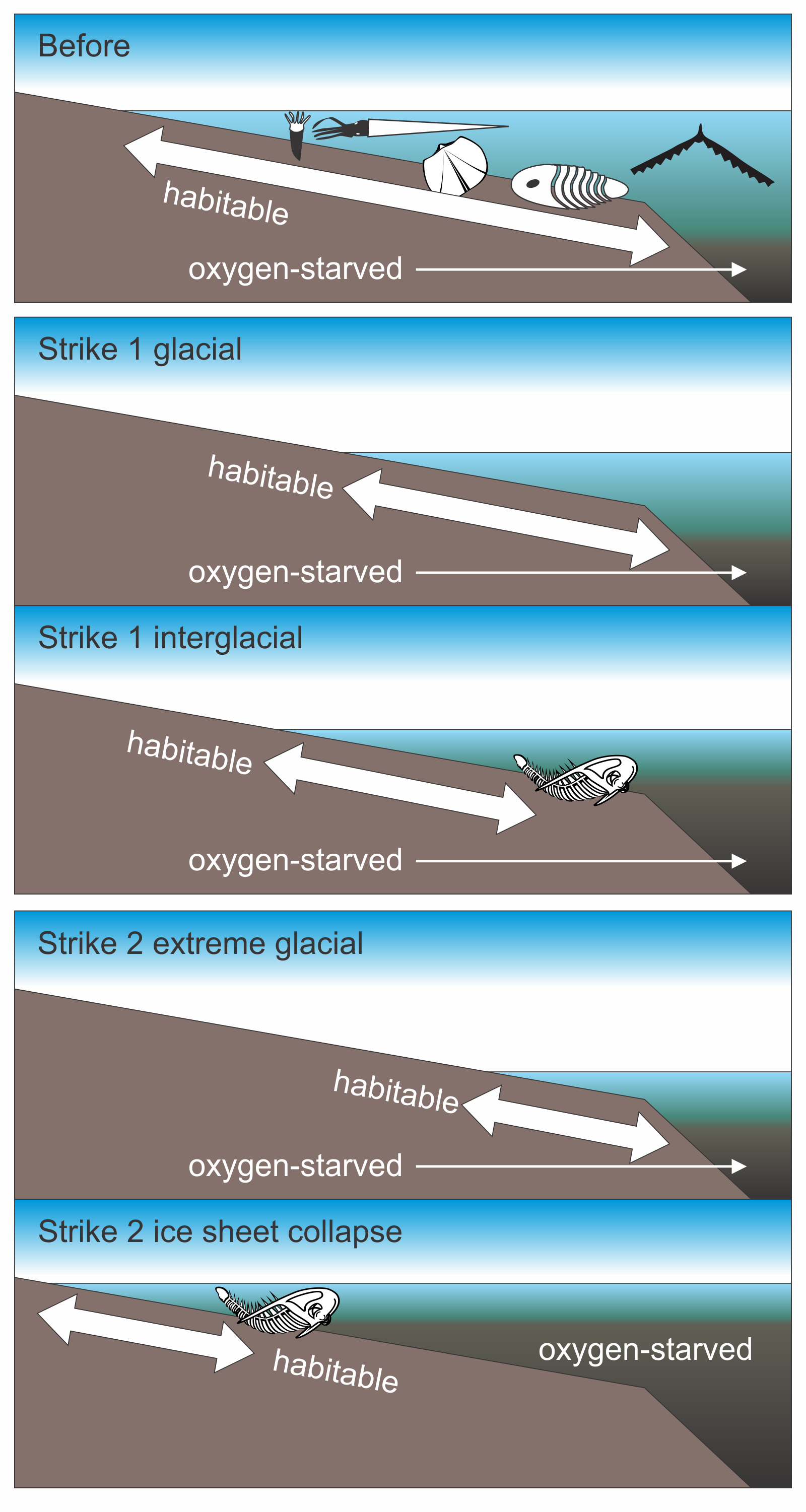
The end-Ordovician was unlike most other extinction events, but it proves the rule: big changes in the carbon cycle trigger big changes in climate, with dire consequences for life on Earth.
Regular readers of Skeptical Science will be familiar with the growing body of evidence that ties four of the “big five” mass extinctions In Earth’s past to episodes of abrupt global warming triggered by intense greenhouse emissions from gargantuan eruptions called Large Igneous Provinces (LIPs). The end-Cretaceous, end Triassic, and end-Permian episodes of abrupt climate change have been the subject of earlier blog posts.
But what about the other one, the one out of five that wasn’t?
The mass extinction at the end of the Ordovician period 444 million years ago extinguished 85% of marine species, but it was associated with global cooling rather than warming. This fascinating episode of Earth’s past was an exception, but it was the exception that proves the rule: big changes in the carbon cycle trigger big changes in climate, with dire consequences for life on Earth.
Complex life on Earth back then was relatively young. It was going through the “Great Ordovician Biodiversification Event” (GOBE), developing complex food webs and proliferating into all the ecological niches (like coral reefs) that would persist until the end of the Permian period.

The world in the Ordovician, showing the Hirnantian glaciation. Redrawn from Torsvik et al, Earth-Science Reviews (2012), Modern coastlines for reference. Hirnantian glaciation extent based on Nutz et al, J. Sedimentary Res. 2013
Most biodiversity was in the waters and seabeds of continental shelves, since deeper water was oxygen-starved. Land life in the early Ordovician was limited to bacteria, algae, fungi, lichen and some primitive, liverwort-like plants. More sophisticated land plants (“cryptophytes” - a loose group of early moss-like plants) appeared in the middle Ordovician about 470 million years ago, and they colonized suitably damp habitats across the globe along with early land arthropods. There was also a major radiation of photosynthesizing phytoplankton at that time. The earliest vascular plants (with woody tissues that support stems, and which can tolerate dryer habitats) appeared shortly before the Hirnantian at around 450 million years ago on the continent of Gondwana. So the latter half of the Ordovician saw the development of a brand-new, plant-dominated terrestrial biosphere.
"a brand-new, plant-dominated terrestrial biosphere"
During the Ordovician the global climate went through a long cooling trend punctuated by short term colder blips that corresponded with carbon cycle perturbations. Those carbon perturbations appear as positive carbon-13 isotope excursions (CIEs in the figure below), meaning that life went through episodes of increased consumption of carbon-12, changing the fossilized ratio between carbon-12 and carbon-13. For more on carbon isotopes see this explainer by NOAA.
As the climate cooled, an ice sheet developed on the southern continent of Gondwana, fluctuating with orbital wobbles and expanding during each positive CIE. There were also a couple of moderate-sized asteroid impacts through this time: Clearwater East, and Slate Islands at around 470 and 450 million years ago respectively. Neither seems to have had much effect on the planet.
In the final million years of the Ordovician, the planet underwent a particularly severe episode of glaciation called the Hirnantian Glaciation, coinciding with the mass extinction. Detailed studies of that geologically brief episode have revealed there was not one but two pulses of mass extinction. The first pulse coincided with the beginning of the Hirnantian Glaciation, and the second with its abrupt end.

Cooling climate before the Hirnantian Mass Extinction. Cyan horizontal band is the Hirnantian Stage. Redrawn from Armstrong & Harper 2014. 13C-derived CO2 range from Pancost et al 2013, Plant spore first appearance simplified from Edwards et al 2014 and Rubinstein et al 2010.
Older papers infer very high CO2 levels in the Ordovician, generating a paradox of a major glaciation during a time of high greenhouse gas levels. Not even the 4% fainter sun back then could explain that away.
But recent work has shown that atmospheric CO2 was falling through the Ordovician, and must have been less than 8 times preindustrial values towards the end. This may sound very high, but with a fainter sun back then and with a large continent over the South Pole, it was low enough to trigger a major continental ice sheet.
Ordovician oxygen levels were also much lower than they are today, at just 15 to 50% of present levels. Oxygen-starved deep water was widespread, and even in the surface layer of the oceans oxygen levels were much lower than they are today, limiting their productivity. At low oxygen levels the atmosphere is less dense, so scattering of shortwave light (ie closer to visible wavelengths than to thermal infrared) by air molecules and clouds is less frequent, leading to slightly more surface warming.
The Hirnantian glaciation was the culmination of the general cooling trend, but it was also much more extreme than the preceding glacial cycles, and its onset (slightly before the Hirnantian) was relatively rapid. Something set the already-glacial climate over a “tipping point” that caused the expansion of ice to an extent far larger than modern Antarctica, causing a drop in global sea levels of 80 to 130 meters. To put that in context, the difference in sea level between today and the Last Glacial Maximum about 26,000 years ago is about the same.
A sea level drop of that magnitude removed a large portion of continental shelf habitat, which trapped most biodiversity on Earth between falling sea levels and oxygen-starved deep water. Those species that lost out in the scramble for habitat went extinct. To make matters even worse, life in temperate latitudes got squeezed between the expanded polar zone and the tropics. Again, species that lost out in the scramble for habitat went extinct.
"trapped most biodiversity ... between falling sea levels and oxygen-starved deep water"
This icehouse world persisted for around about 1 million years with the ice sheet waxing and waning through orbitally-controlled glacial-interglacial cycles, like they did in the most recent ice ages. Recent work has linked the first pulse of extinction to the earliest of those interglacials, which suggests that as sea levels rose, oxygen-starved seawater travelled inland with them, even further compressing the habitable zone.
Just before the second strike of the Hirnantian mass extinction there was strong intensification of the glaciation and sea levels dropped even lower. Then, within perhaps 200,000 years, the climate did a complete about-face as the ice sheet collapsed in response to about a 6°C (11°F) rise in temperatures. This resulted in an abrupt and total reversal of the sea level fall, returning to pre-Hirnantian levels or higher. Oxygen-starved water advanced up the continental shelves depositing sulfurous black muds, compressing the habitable zone so that middle-depth-adapted life lost habitat and went extinct preferentially. There was also a phytoplankton extinction at this time.
The strongest and sharpest spike in the Hirnantian carbon isotope excursion is associated with this 2nd extinction pulse, indicating a surge in light carbon (carbon-12) burial, possibly the result of a big influx of nutrients washed from land by rapidly melting ice.
The cumulative effect of this environmental whiplash was the permanent loss of about 85% of marine species, making this 2nd after the Permian Mass Extinction in terms of species loss. But interestingly land plant diversity doesn’t seem to have suffered.
Some ice persisted, and sea levels continued to fluctuate throughout the subsequent Silurian period, but a mass extinction on the scale of the Hirnantian was not seen again until the late Devonian.

The 2 pulses of the end-Ordovician extinction. Temperature and extinction pattern from Armstrong & Harper 2014, sea-level change, carbon isotope curve and extinction zones from Ghienne et al 2014. All scaled in time to match orbitally-tuned timeframe in figure 3 of Ghienne et al 2014.
So what could trigger such paroxysmal planetary change? Various theories have been put forward including:-
Strike 1:
Strike 2:
I should note at the outset that this is an area of active research, and that detailed correlation of events in Hirnantian strata across the world is far from trivial, as discussed here and here.
This was a time of mountain building (the Taconic/Caledonian orogeny) and violent ashy volcanic eruptions as the continents of Laurentia, Baltica and Avalonia began to collide. Mountain building, lots of fresh volcanic ash and erosion tend to accelerate the weathering of silicate rocks, which draws down CO2 from the atmosphere, cooling the planet on a timeframe of hundreds of thousands to millions of years. And indeed, strontium isotopes confirm a large increase in the contribution of weathered volcanic rocks into ocean waters between about 470 and 450 million years ago. Neodymium isotopes (a proxy for ancient sea level change) show that ice sheets were in place well before the Hirnantian, and so the Hirnantian represents an extreme within a long-established glaciation.
To explain the extreme nature and rapid onset of the Hirnantian glaciation, it could be that this progressive cooling and weathering CO2 drawdown reached a tipping point as more and more water got locked up in ice, reflecting more and more sunlight as ice spread, creating a runaway glaciation.
But weathering alone cannot explain the large positive carbon and sulfur isotope spikes observed. They tell us that in the Hirnantian there was a major increase in photosynthesizing activity and a corresponding major increase in organic carbon burial in the seafloor. Typically this requires a big influx of nutrients washed from the land, fertilizing plankton activity. Ordovician sediments are often rich in fossil algae Gloeocapsomorpha prisca, implying widespread algal blooms, and enhanced biological productivity in the surface layer of the ocean uses up dissolved oxygen, causing the spread of oxygen-starved ocean dead zones.
"a massive increase in liberation of nutrients from the land ... the rate of carbon burial in the oceans was about 15 times present levels!"
In their paper titled “First plants cooled the Ordovician,” Lenton et al demonstrated that even the early moss-like plants must have accelerated rock weathering rates, simultaneously drawing down CO2 and supplying nutrients like phosphorous to the oceans, which would have fertilized plankton activity. The Darriwillian CIE occurring very shortly after the radiation of cryptophyte plants makes sense in this context. But the Hirnantian CIE requires a tripling of the phosphorous supply which suggests a massive increase in liberation of nutrients from the land, and carbon isotopes show that the rate of carbon burial in the oceans was about 15 times present levels! This can be explained by the radiation of the earliest vascular plants onto previously unvegetated land, causing a pulse of phosphorus weathering as they spread, fertilizing the oceans, boosting ocean productivity, and locking CO2 away in degradation-resistant vascular tissue at the same time.
So it seems that although both geological and biological causes conspired to prime the planet for glaciation, it was likely the initial radiation of vascular plants that pushed the climate over a tipping point resulting in an abrupt and severe glaciation that in turn caused the first pulse of the mass extinction.

Environmental whiplash in the Hirnantian. Based on Armstrong & Harper 2014 modified to match sequence in Ghienne et al 2014.
But what explains the 2nd strike?
We know from the most recent ice ages that a complicated set of feedbacks causes the waxing and waning of ice sheets in response to varying sunlight intensity with orbital wobbles on timescales of tens and hundreds of millennia. These factors sometimes conspire to create relatively long warmish interglacials such as MIS 11 about 400,000 years ago. But observations of Hirnantian rocks suggest that the climate went through about 5 such oscillations without triggering collapse of the ice sheet and drastic sea level rise, or a 2nd extinction pulse. This suggests something else must have come into play at the 2nd extinction.
Young et al proposed that as ice sheets expanded they covered ever more land area, preventing silicate weathering from drawing down CO2 from the atmosphere, allowing volcanic CO2 to build and warm the planet past that tipping point again, resulting in the collapse of the Hirnantian ice sheet. It’s true that the ice sheet collapse happened just after a strong intensification of the already severe glaciation, but the buildup of background volcanic CO2 is slow process, requiring hundreds of thousands of years, whereas the termination of the Hirnantian was rapid.
The symptoms of abrupt warming and sea level rise have been linked to large and rapid greenhouse gas emissions by Large Igneous Province eruptions for numerous other warming episodes in Earth’s past, and several of those have been associated with mass extinctions. Examples include the mid-Cambrian, the end-Permian, the end-Triassic, the Toarcian, end-Cretaceous, the PETM and others (see this post). Both Kravchinsky in 2012, and Kidder & Worsley in 2012, made the association between the end-Ordovician and such a LIP eruption, but could not point to a well-dated LIP that matched. Subsequent work by Khudoley et al has identified the Suordakh LIP on the eastern margin of Siberia that dates to exactly the right time: 444 million years ago, albeit with a wide uncertainty of ± 22 million years. The presence of malformed plankton also hints at possible ocean acidification at this time, a phenomenon that typifies other LIP events.
So, tentatively, it seems that this second pulse of the end-Ordovician extinction might have more in common with other mass extinction events after all. Greenhouse gas emissions from a Large Igneous Province may have warmed the planet and terminated the Hirnantian glaciation, thereby triggering the 2nd strike of the Hirnantian (end-Ordovician) mass extinction, in just the same way LIPs did in the other 4 of the big 5 mass extinctions.
This episode of Earth’s past shows that innovative new species can drastically alter the climate when they proliferate across the globe. The evolution and spread of terrestrial plants at the end of the Ordovician not only may have triggered one of the biggest mass extinctions of life on Earth, but it also boosted oxygen levels. Those higher oxygen levels led to the oxygenation of deep ocean water, breaking the link between subsequent ice ages and mass extinctions.
And those higher oxygen levels also enabled the emergence of large and energetic vertebrates, eventually leading to a new innovative species with planet-transforming, mass-extinction-causing power - us.
______
This is an expansion from Howard Lee’s book: “Your Life as Planet Earth,” an account of past climate changes, how they affected life, and how Earth and life affected climate.
Earth Impact Database, 2015. www.unb.ca/passc/ImpactDatabase/ (Accessed: 27/8/2015)
Feulner, G. (2012). The faint young Sun problem. Reviews of Geophysics,50(2).
Kidder, D. L., & Worsley, T. R. (2012). A human-induced hothouse climate?.GSA Today, 22(2), 1-11.
Posted by howardlee on Thursday, 10 September, 2015
 |
The Skeptical Science website by Skeptical Science is licensed under a Creative Commons Attribution 3.0 Unported License. |